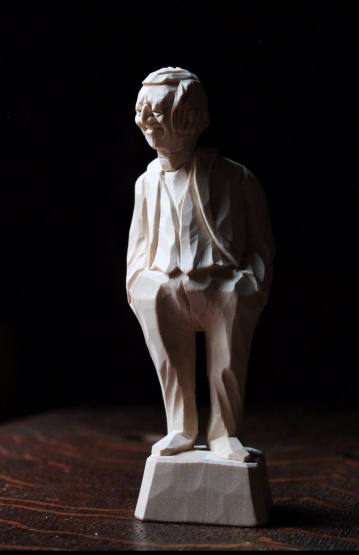
My version/copy, in basswood, of a carved figure by Paul Emile Caron
I often listen to audio books while carving in the shop, and I recently finished Irving Stone’s 1934 book Lust for Life, a biographical novel about the life and work of Vincent van Gogh. Early on, as learning exercises, Vincent copied works that he admired and, as Stone writes, “Vincent learned that it is always the simplest piece of art which has practiced the most rigid elimination, and is therefore the most difficult to duplicate.”
I tried something similar a couple weeks ago when I carved the little (5 1/2 inches tall) figure to the left, my copy of a piece that I picked up several years ago by, I believe, Paul-Emile Caron (1915-1987). He lived and worked in St.-Jean-Port-Joli, Quebec and most of his carvings were done in the 1950s and 60s. I admire his figures and am fascinated by how much can be expressed with the cuts of the knife, a long tradition that can be seen in the work of famous Swedish carver Axel Petersson Döderhultarn and modern master Harley Refsal, among many others.

Original carving by Paul-Emile Caron in pine
I’ve seen many of Caron’s pieces through photographs, and, as would be expected, he hit the sweet spot on some more than others. I’ve been captivated by this one. In fact, I made a sketch of it which I used in a post a couple years ago.
I had no desire for a duplicate, but I did want to learn from Caron by careful study and observation of this piece. Making a copy forced me to look and consider much more deeply than I had in terms of both design and technique. For every minute of cutting I, necessarily, spent at least three minutes studying the original. In making it, I learned and developed a deeper appreciation. As a bonus, I’ll have a reminder of the exercise in my shop, a sort of twin brother to the original, but with a somewhat different expression. I documented on the bottom that it was a copied version of Caron’s design.
Here are just a couple detailed examples of things observed on Caron’s carving:

The sweeping knife overcut indicates Caron’s method for removing the wedge of wood between the arm and body.

The chatter marks resulting from the knife blade twisting through the tight cut are left strategically and purposely to enhance the shadows of the folds in the cloth.

The top of the shoe (end grain) was reduced through a series of thin cuts, as indicated by the knife marks on the bottom of the pant leg.
I found that the blades on this pocket knife served well to make all of the cuts other than a couple gouge cuts on the back that Caron used to indicate folds in the jacket. Pleasant work while sitting outside.


I’ll never carve this particular piece again, but the realizations and lessons will last and be applied in who-knows-what ways. And since this little guy, it’s been back to the adze for me; I have several bowls underway in various stages. More on those later…

Yet another thing to admire. I am a very recent subscriber to your blog but have enjoyed your site for over a year. I have worked with wood for many years but you have inspired me to try new things. I recently completed a horse from your plans and have gathered some walnut, maple and Bradford pear downed from storms. A Swedish carving axe and gouges and been purchased, so now I think I’m ready to try my hand at some bowls and spoons. I know I have far to go but looking forward to the journey.
LikeLike
Really nice to hear that, Scott. Enjoy the journey, including the simple pleasure of making shavings.
LikeLike
Wow. Just, wow. Inspirational!
LikeLiked by 1 person
Great job David! I admire your work and skill.
LikeLiked by 1 person
Interesting how the two have different characters, Caron’s relaxed,a little weary, your’s much more engaged, you can detect a sense of humour…!
LikeLike
It did seem to work out that way! I certainly can’t attribute much of it to skill and intention. I was definitely struck by how subtle facial expressions can be — a tiny chip here or there can make a big difference.
LikeLike
I should have also mentioned in the post that Harley Refsal wrote a great book called “Scandinavian Figure Carvings” (Fox Chapel Publishing) that traces the development of the art form and highlights the work of many carvers, including the story of Axel Petersson Doderhultarn.
LikeLike
All Your Carvings Are To Be Admired & Studied ! Good Job ! !
LikeLiked by 1 person
David, I appreciate your post. As a painter/draftsman, I’m constantly doing master copies for the purpose of learning and dialoguing with past artists. I recently finished a master copy of Eugene Delacroix’s self portrait. Reading your thoughts here made smile, as I could have written the exact same things as a result of working on Delacroix – especially the ways in which a tiny brushstroke changes a facial expression.
LikeLiked by 1 person
Thanks for sharing that, B.J. Your figure and portrait work is stunning and beautiful.
LikeLike